2006 CHEVROLET MALIBU ECU
[x] Cancel search: ECUPage 59 of 442
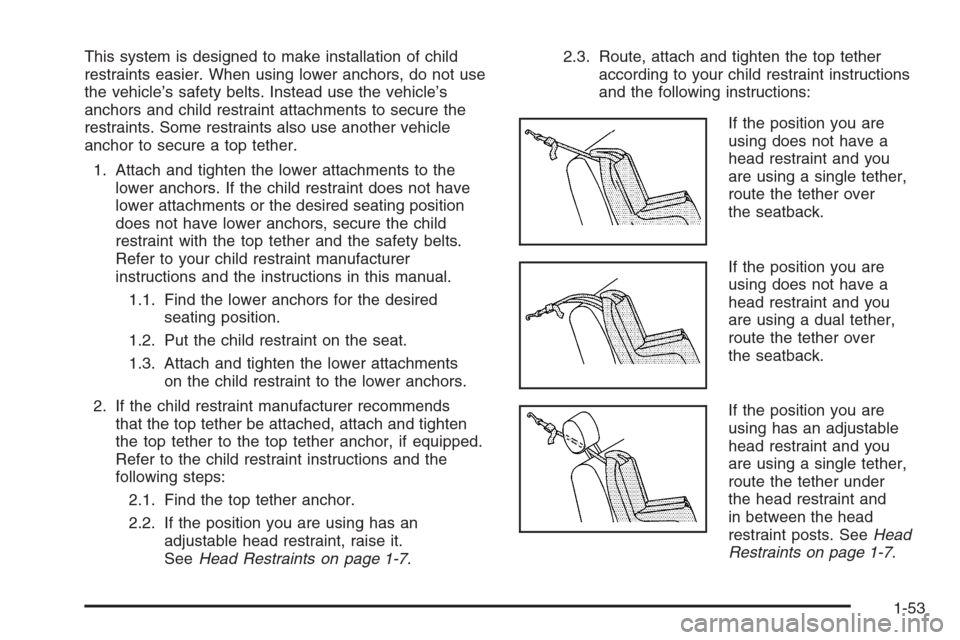
This system is designed to make installation of child
restraints easier. When using lower anchors, do not use
the vehicle’s safety belts. Instead use the vehicle’s
anchors and child restraint attachments to secure the
restraints. Some restraints also use another vehicle
anchor to secure a top tether.
1. Attach and tighten the lower attachments to the
lower anchors. If the child restraint does not have
lower attachments or the desired seating position
does not have lower anchors, secure the child
restraint with the top tether and the safety belts.
Refer to your child restraint manufacturer
instructions and the instructions in this manual.
1.1. Find the lower anchors for the desired
seating position.
1.2. Put the child restraint on the seat.
1.3. Attach and tighten the lower attachments
on the child restraint to the lower anchors.
2. If the child restraint manufacturer recommends
that the top tether be attached, attach and tighten
the top tether to the top tether anchor, if equipped.
Refer to the child restraint instructions and the
following steps:
2.1. Find the top tether anchor.
2.2. If the position you are using has an
adjustable head restraint, raise it.
SeeHead Restraints on page 1-7.2.3. Route, attach and tighten the top tether
according to your child restraint instructions
and the following instructions:
If the position you are
using does not have a
head restraint and you
are using a single tether,
route the tether over
the seatback.
If the position you are
using does not have a
head restraint and you
are using a dual tether,
route the tether over
the seatback.
If the position you are
using has an adjustable
head restraint and you
are using a single tether,
route the tether under
the head restraint and
in between the head
restraint posts. SeeHead
Restraints on page 1-7.
1-53
Page 60 of 442
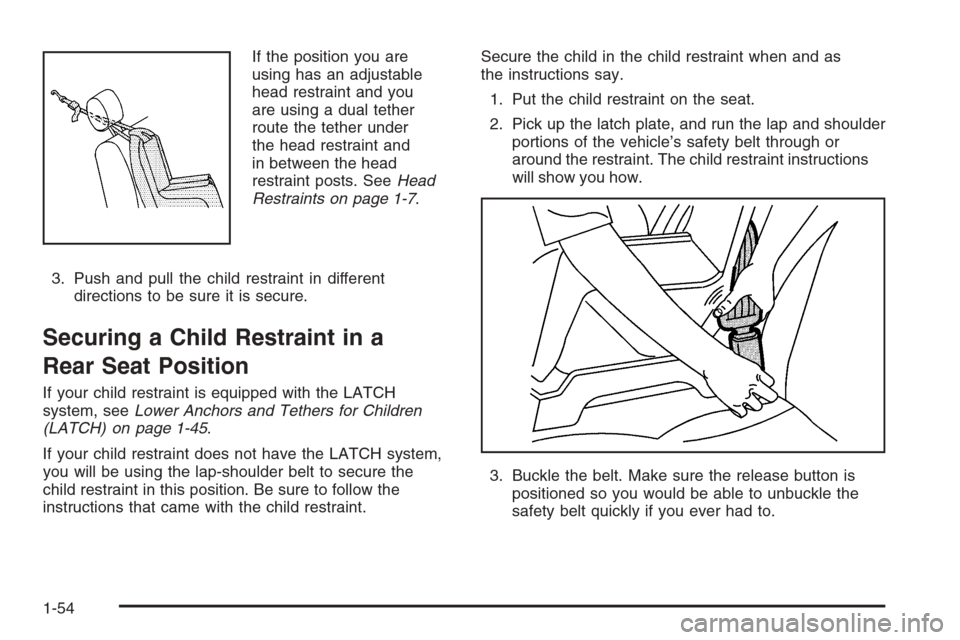
If the position you are
using has an adjustable
head restraint and you
are using a dual tether
route the tether under
the head restraint and
in between the head
restraint posts. SeeHead
Restraints on page 1-7.
3. Push and pull the child restraint in different
directions to be sure it is secure.
Securing a Child Restraint in a
Rear Seat Position
If your child restraint is equipped with the LATCH
system, seeLower Anchors and Tethers for Children
(LATCH) on page 1-45.
If your child restraint does not have the LATCH system,
you will be using the lap-shoulder belt to secure the
child restraint in this position. Be sure to follow the
instructions that came with the child restraint.Secure the child in the child restraint when and as
the instructions say.
1. Put the child restraint on the seat.
2. Pick up the latch plate, and run the lap and shoulder
portions of the vehicle’s safety belt through or
around the restraint. The child restraint instructions
will show you how.
3. Buckle the belt. Make sure the release button is
positioned so you would be able to unbuckle the
safety belt quickly if you ever had to.
1-54
Page 62 of 442
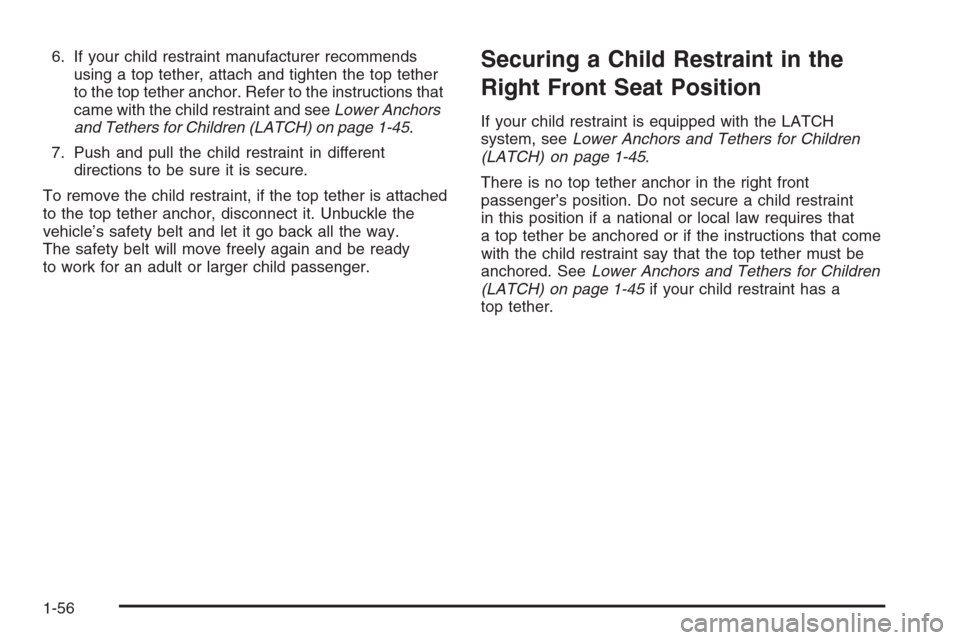
6. If your child restraint manufacturer recommends
using a top tether, attach and tighten the top tether
to the top tether anchor. Refer to the instructions that
came with the child restraint and seeLower Anchors
and Tethers for Children (LATCH) on page 1-45.
7. Push and pull the child restraint in different
directions to be sure it is secure.
To remove the child restraint, if the top tether is attached
to the top tether anchor, disconnect it. Unbuckle the
vehicle’s safety belt and let it go back all the way.
The safety belt will move freely again and be ready
to work for an adult or larger child passenger.Securing a Child Restraint in the
Right Front Seat Position
If your child restraint is equipped with the LATCH
system, seeLower Anchors and Tethers for Children
(LATCH) on page 1-45.
There is no top tether anchor in the right front
passenger’s position. Do not secure a child restraint
in this position if a national or local law requires that
a top tether be anchored or if the instructions that come
with the child restraint say that the top tether must be
anchored. SeeLower Anchors and Tethers for Children
(LATCH) on page 1-45if your child restraint has a
top tether.
1-56
Page 63 of 442
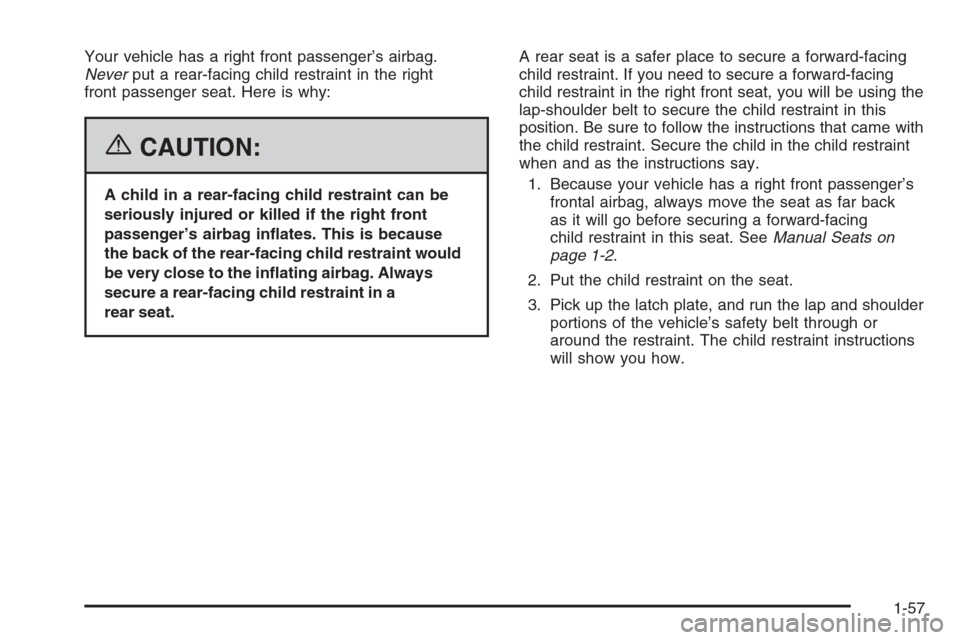
Your vehicle has a right front passenger’s airbag.
Neverput a rear-facing child restraint in the right
front passenger seat. Here is why:
{CAUTION:
A child in a rear-facing child restraint can be
seriously injured or killed if the right front
passenger’s airbag in�ates. This is because
the back of the rear-facing child restraint would
be very close to the in�ating airbag. Always
secure a rear-facing child restraint in a
rear seat.A rear seat is a safer place to secure a forward-facing
child restraint. If you need to secure a forward-facing
child restraint in the right front seat, you will be using the
lap-shoulder belt to secure the child restraint in this
position. Be sure to follow the instructions that came with
the child restraint. Secure the child in the child restraint
when and as the instructions say.
1. Because your vehicle has a right front passenger’s
frontal airbag, always move the seat as far back
as it will go before securing a forward-facing
child restraint in this seat. SeeManual Seats on
page 1-2.
2. Put the child restraint on the seat.
3. Pick up the latch plate, and run the lap and shoulder
portions of the vehicle’s safety belt through or
around the restraint. The child restraint instructions
will show you how.
1-57
Page 65 of 442
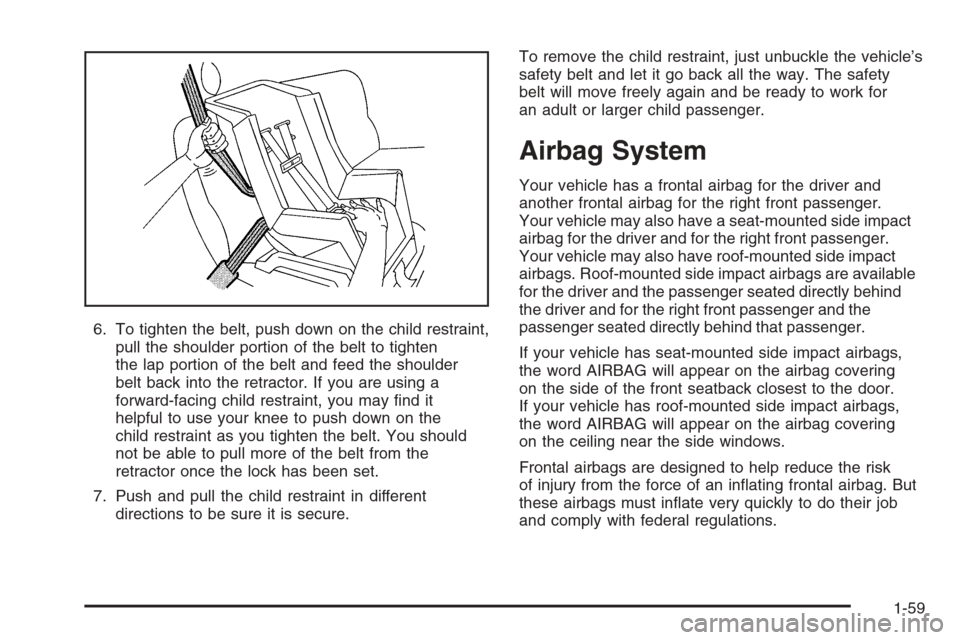
6. To tighten the belt, push down on the child restraint,
pull the shoulder portion of the belt to tighten
the lap portion of the belt and feed the shoulder
belt back into the retractor. If you are using a
forward-facing child restraint, you may �nd it
helpful to use your knee to push down on the
child restraint as you tighten the belt. You should
not be able to pull more of the belt from the
retractor once the lock has been set.
7. Push and pull the child restraint in different
directions to be sure it is secure.To remove the child restraint, just unbuckle the vehicle’s
safety belt and let it go back all the way. The safety
belt will move freely again and be ready to work for
an adult or larger child passenger.
Airbag System
Your vehicle has a frontal airbag for the driver and
another frontal airbag for the right front passenger.
Your vehicle may also have a seat-mounted side impact
airbag for the driver and for the right front passenger.
Your vehicle may also have roof-mounted side impact
airbags. Roof-mounted side impact airbags are available
for the driver and the passenger seated directly behind
the driver and for the right front passenger and the
passenger seated directly behind that passenger.
If your vehicle has seat-mounted side impact airbags,
the word AIRBAG will appear on the airbag covering
on the side of the front seatback closest to the door.
If your vehicle has roof-mounted side impact airbags,
the word AIRBAG will appear on the airbag covering
on the ceiling near the side windows.
Frontal airbags are designed to help reduce the risk
of injury from the force of an in�ating frontal airbag. But
these airbags must in�ate very quickly to do their job
and comply with federal regulations.
1-59
Page 67 of 442
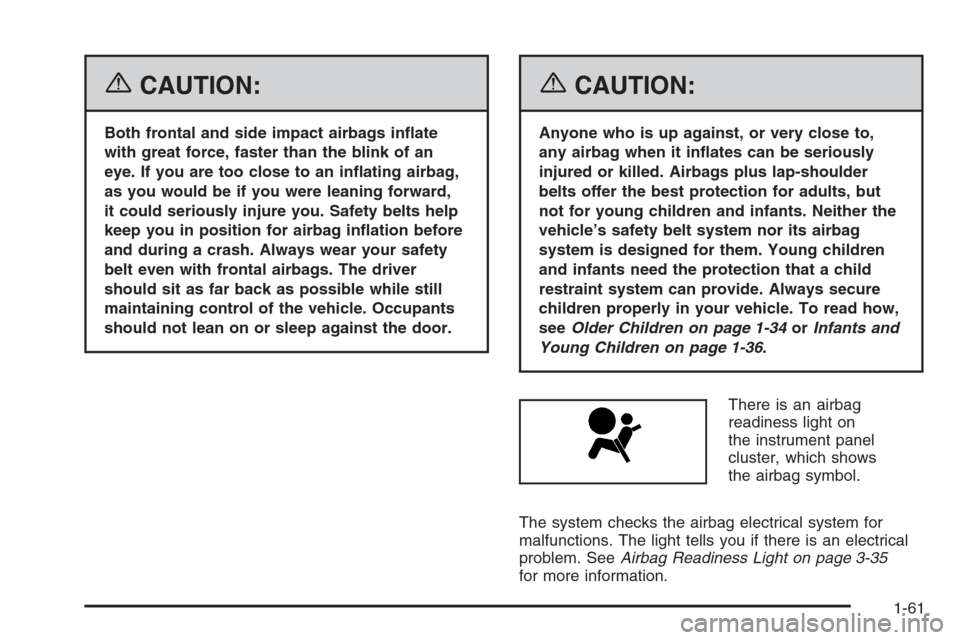
{CAUTION:
Both frontal and side impact airbags in�ate
with great force, faster than the blink of an
eye. If you are too close to an in�ating airbag,
as you would be if you were leaning forward,
it could seriously injure you. Safety belts help
keep you in position for airbag in�ation before
and during a crash. Always wear your safety
belt even with frontal airbags. The driver
should sit as far back as possible while still
maintaining control of the vehicle. Occupants
should not lean on or sleep against the door.
{CAUTION:
Anyone who is up against, or very close to,
any airbag when it in�ates can be seriously
injured or killed. Airbags plus lap-shoulder
belts offer the best protection for adults, but
not for young children and infants. Neither the
vehicle’s safety belt system nor its airbag
system is designed for them. Young children
and infants need the protection that a child
restraint system can provide. Always secure
children properly in your vehicle. To read how,
seeOlder Children on page 1-34orInfants and
Young Children on page 1-36.
There is an airbag
readiness light on
the instrument panel
cluster, which shows
the airbag symbol.
The system checks the airbag electrical system for
malfunctions. The light tells you if there is an electrical
problem. SeeAirbag Readiness Light on page 3-35
for more information.
1-61
Page 71 of 442
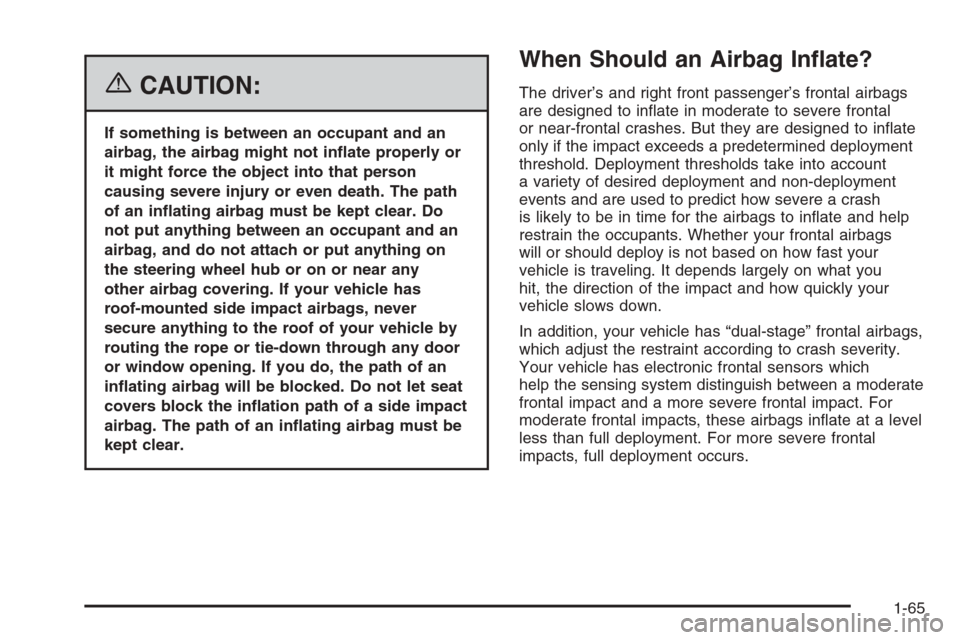
{CAUTION:
If something is between an occupant and an
airbag, the airbag might not in�ate properly or
it might force the object into that person
causing severe injury or even death. The path
of an in�ating airbag must be kept clear. Do
not put anything between an occupant and an
airbag, and do not attach or put anything on
the steering wheel hub or on or near any
other airbag covering. If your vehicle has
roof-mounted side impact airbags, never
secure anything to the roof of your vehicle by
routing the rope or tie-down through any door
or window opening. If you do, the path of an
in�ating airbag will be blocked. Do not let seat
covers block the in�ation path of a side impact
airbag. The path of an in�ating airbag must be
kept clear.
When Should an Airbag In�ate?
The driver’s and right front passenger’s frontal airbags
are designed to in�ate in moderate to severe frontal
or near-frontal crashes. But they are designed to in�ate
only if the impact exceeds a predetermined deployment
threshold. Deployment thresholds take into account
a variety of desired deployment and non-deployment
events and are used to predict how severe a crash
is likely to be in time for the airbags to in�ate and help
restrain the occupants. Whether your frontal airbags
will or should deploy is not based on how fast your
vehicle is traveling. It depends largely on what you
hit, the direction of the impact and how quickly your
vehicle slows down.
In addition, your vehicle has “dual-stage” frontal airbags,
which adjust the restraint according to crash severity.
Your vehicle has electronic frontal sensors which
help the sensing system distinguish between a moderate
frontal impact and a more severe frontal impact. For
moderate frontal impacts, these airbags in�ate at a level
less than full deployment. For more severe frontal
impacts, full deployment occurs.
1-65
Page 76 of 442
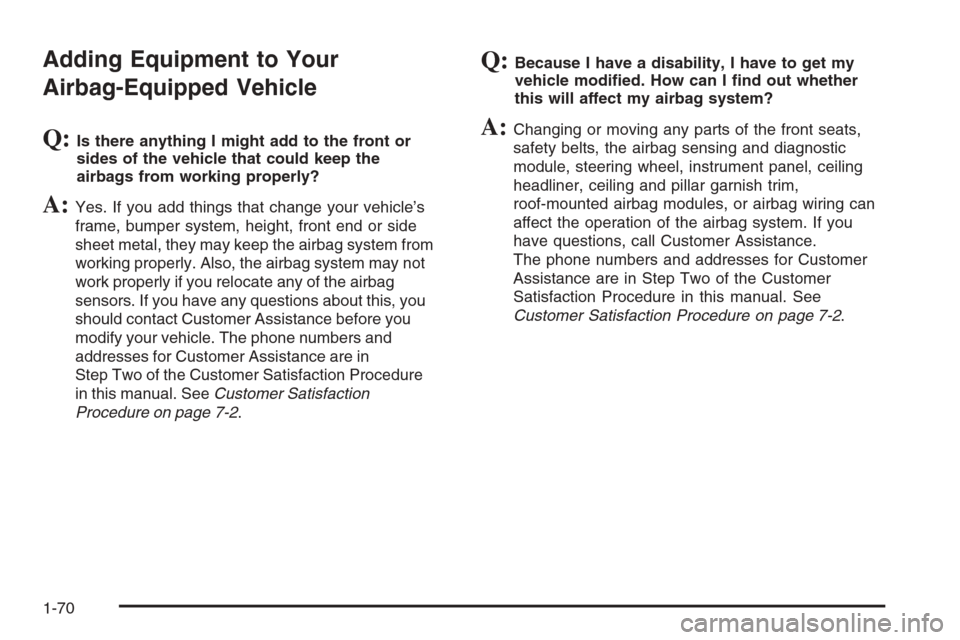
Adding Equipment to Your
Airbag-Equipped Vehicle
Q:Is there anything I might add to the front or
sides of the vehicle that could keep the
airbags from working properly?
A:Yes. If you add things that change your vehicle’s
frame, bumper system, height, front end or side
sheet metal, they may keep the airbag system from
working properly. Also, the airbag system may not
work properly if you relocate any of the airbag
sensors. If you have any questions about this, you
should contact Customer Assistance before you
modify your vehicle. The phone numbers and
addresses for Customer Assistance are in
Step Two of the Customer Satisfaction Procedure
in this manual. SeeCustomer Satisfaction
Procedure on page 7-2.
Q:Because I have a disability, I have to get my
vehicle modi�ed. How can I �nd out whether
this will affect my airbag system?
A:Changing or moving any parts of the front seats,
safety belts, the airbag sensing and diagnostic
module, steering wheel, instrument panel, ceiling
headliner, ceiling and pillar garnish trim,
roof-mounted airbag modules, or airbag wiring can
affect the operation of the airbag system. If you
have questions, call Customer Assistance.
The phone numbers and addresses for Customer
Assistance are in Step Two of the Customer
Satisfaction Procedure in this manual. See
Customer Satisfaction Procedure on page 7-2.
1-70